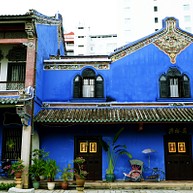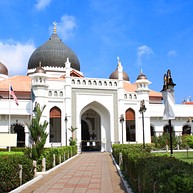
-
![Kek Lok Si Temple in Penang]() Provided by: Mike Fuchslocher/Shutterstock.com
Provided by: Mike Fuchslocher/Shutterstock.com

Our travel guides are free to read and explore online. If you want to get your own copy, the full travel guide for this destination is available to you offline* to bring along anywhere or print for your trip.
*this will be downloaded as a PDF.Price
€4,95
Kek Lok Si Temple
The guide was updated:Claimed as the largest Buddhist temple complex in southeast Asia, Kek Lok Si – the Temple of Paradise – is marked by the Ten Thousand Buddha Pagoda and a statue of Kuan Yin, the Goddess of Mercy. A newer temple to the Goddess was built in 2001-2002.
Useful Information
- Address: Ayer Hitam, Pulau Pinang, Penang
Digital Travel Guide Download
Our travel guides are free to read and explore online. If you want to get your own copy, the full travel guide for this destination is available to you offline* to bring along anywhere or print for your trip.
*this will be downloaded as a PDF.Price
€4,95

Batu Ferringhi is Penang’s main resort area, featuring a long strip of hotels, restaurants, bars, and shops along the island's best beach. Most visitors end up staying here, as Batu Ferringhi offers a range of accommodation from cheap and cheerful guesthouses to five-star luxury hotels. The resort area also provides a wide variety of watersports, including water skiing, windsurfing, parasailing and scuba diving.
Read more

Penang Hill
For a superb view over Penang and the Straits, take the funicular railway to the top of Bukit Bendera hill. The ride takes 30 minutes and the summit, 830 m (2,727 ft.) above sea level, is, with an average temperature of 3 degrees Celsius, cooler than the steamy coast.
Read more

Snake Temple
Dozens of venomous pit vipers slither and coil among the urns, roof beams and potted trees within this bizarre Chinese temple, built in 1850, and sacred to the deity Chro Soo Kong. The snakes – regarded as benevolent spirits – are seen as guardians of the temple.
Read more

Penang Botanical Gardens
Hundreds of palms, tropical trees, shrubs, ferns, orchids and other flowering plants grace the 30 hectares of grounds, glasshouses, ponds and nurseries at the Botanical Gardens. A popular picnic spot for local families, as well as for tourists stopping by for having a break from sightseeing.
Read more

Entopia Butterfly Farm
Penang’s famous butterfly farm at Entopia Natureland is the world’s largest. With garden pavilions and breeding areas for more than 50 species of spectacularly colourful butterflies and insects, which all the same share this ecological space with a variety of other animal species such as invertebrates and small reptiles, up to 4,000 gorgeous living specimens can be seen at any time.
Read more

Kek Lok Si Temple
Claimed as the largest Buddhist temple complex in southeast Asia, Kek Lok Si – the Temple of Paradise – is marked by the Ten Thousand Buddha Pagoda and a statue of Kuan Yin, the Goddess of Mercy. A newer temple to the Goddess was built in 2001-2002.
Read more

Monkey Beach & Penang National Park
Monkey Beach, also known as Teluk Duyung, is popular for its calm water, fine sand, picnic tables, and a troop of half-tame macaques. It is an attractive destination for a 2-3 hour walk through the tropical woodland of Penang National Park, Taman Negara Pulau Pinang. Be sure to check in at the park office before setting off.
Read more

Fort Cornwallis
Fort Cornwallis is George Town’s most prominent historical landmark. Its star-shaped 18th-century ramparts on the waterfront enclose an array of British colonial buildings, including prison cells, a powder magazine, a chapel, a harbour beacon, and bronze cannons still mounted on the battlements.
Read more

Kuan Yin Temple
Kuan Yin, the Goddess of Mercy Temple, was built during the 19th century by Chinese settlers of Hokkien descent. It is the oldest Chinese temple in Georgetown, named in honour of a devout Buddhist sage.
Read more

Cheong Fatt Tze Mansion
Cheong Fatt Tze, the Blue Mansion, was one of the wealthiest merchants of the 19th century, and Penang Straits Settlement imported artisans from China to build this opulent 38-room mansion. With its five courtyards, carved woodwork, Gothic louvered windows and cast iron, the mansion is a fascinating fusion of East and West culture. The building was restored at a cost of 7.6 million ringgit, and it is crammed with sculptures, antique furniture and tapestries, while now being a unique boutique hotel. However, it is also open for non-residents during guided tours, so book one ahead.
Read more

Khoo Kongsi Association
Khoo Kongsi was built just over a century ago, and it is the finest example of a Hokkien Chinese ‘clan house’ complex in Georgetown. Its grand hall is replete with decorative carvings and ornamented columns, and the red tiled roof is crowned with extravagant carvings of demons, dragons and other creatures from Chinese mythology. The hall is surrounded by a complex of shops, houses and other buildings, within a rectangle of defensive walls.
Read more

Sri Mahamariamman Temple
The dazzlingly colourful Sri Mahamariamman Temple is the cultural and religious hub of George Town’s ‘Little India’ quarter, home to immigrants from the subcontinent for more than a century. Encrusted with garishly painted statues of deities, demons, and mythical creatures, the Sri Mahamariamman is the oldest of the city’s Hindu temples and is still in daily use. Inside stands a valuable statue of the Hindu deity Lord Subramanya, lavishly embellished with gold and precious stones.
Read more

Kapitan Keling Mosque
Muslim Indian sepoys (soldiers) of the British East India Company’s Penang garrison built Masjid Kapitan Keling in 1801. It has been extensively restored and expanded in the two centuries since. Above the yellow domes and turrets of the mosque compound towers a tall minaret.
Read more


